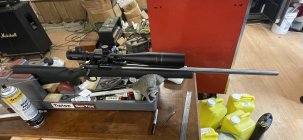The bullet becomes more stable as distance increases because its linear velocity decreases faster than its rotational velocity. Thus, at some point down range the bullet will be rotating much faster relative to its linear velocity than it was when it first exited the bore, and its gyroscopic stability (Sg) will be enhanced. Nonetheless, that won't make precision improve if the bullet trajectory
is already offline as the beneficial effect on stability of the bullet rotational velocity/linear velocity ratio begins to take effect.
In my hands, barrel twist rates that are just slightly insufficient (i.e. twist rates that generate Sgs in perhaps the 1.3 to 1.4 range) have not affected precision in any way that is easy to detect. In other words, pushing bullets with Sgs in the 1.3 to 1.4 range shouldn't cause the groups to open up markedly. However, the bullet may behave as though its BC is actually lower than than it really is, and exhibit greater-than-expected wind deflection. When the barrel twist rate was so slow that the bullet Sg got down close to the 1.1 range (or below) is when the 3", 4", or even 5" groups at 100 yd started to show up for me.
Without a doubt, some of the the Hornady ELDM .224" bullets (73, 75 and 80 gr) appear to require a much faster twist rate than Hornady may have originally suggested for full stability (i.e. Sg >/= 1.5). Increasing velocity will certainly have a minor beneficial effect on bullet stability, but the effect is usually rather small in that it takes a pretty substantial increase in velocity to improve the predicted Sg by the same amount that even a very small increase in the barrel twist rate can.
Going with the 7-twist barrels is without a doubt the correct solution to this issue, but whether the increase in twist rate affects the apparent shot dispersions you obtained at 100 yd versus 700 yd is another story. That should only happen if the very slight decrease in group spread you observed at 700 yd versus 100 yd was actually caused by the insufficient twist rate, and I suspect that is not what's happening. But in fairness, you are running these bullets at an Sg range (i.e 1.2 to 1.3) that is slightly closer to a value I have found will cause the groups to open up markedly (~1.1). It may well be that groups start to open up noticeably more at Sgs below 1.3 and I have only had experience with Sgs that were either
really low (</= ~1.1), or just
slightly low (1.3 to 1.4). So you could be operating in a gyroscopic stability region where an undesirable effect such as increasing group spread could become much more obvious. Nonetheless, I have seen many claims over the years by shooters of rifles that group more tightly at distance than at short range. IMO - the most likely or common explanation for this behavior is scope parallax issues. There will always be those that believe there are alternative explanations such as epicyclic swerve to explain how group spread could actually decrease with distance. Bryan Litz, someone that knows a lot more than I do about these things, says that isn't so, and I choose to accept his explanation:
The good news here is that my
opinion carries little weight as compared to what your actual testing will reveal once the new 7-twist barrels are installed. I appreciate that it may be some time before this happens, but please let us know how the 7-twist barrels affected short- versus long-range precision once they have been installed.











